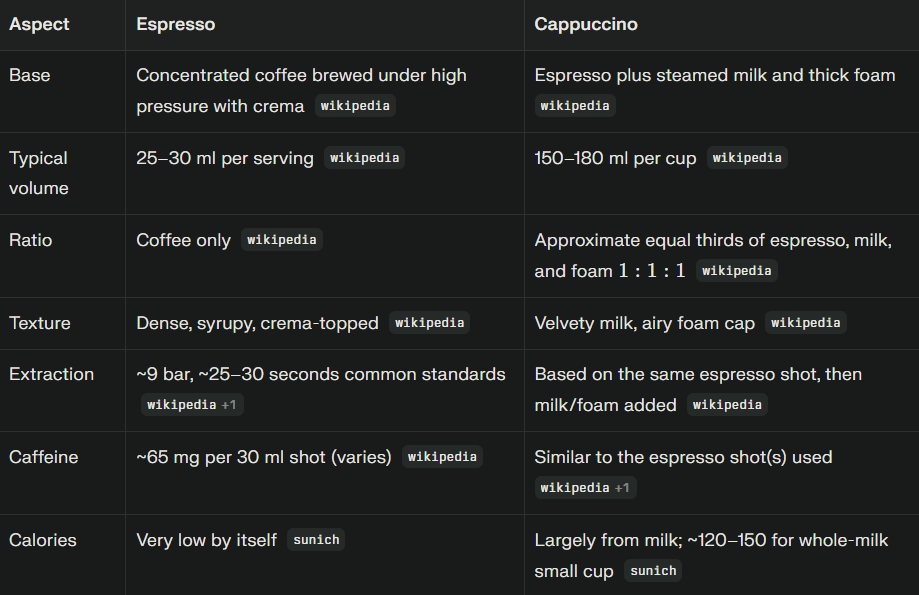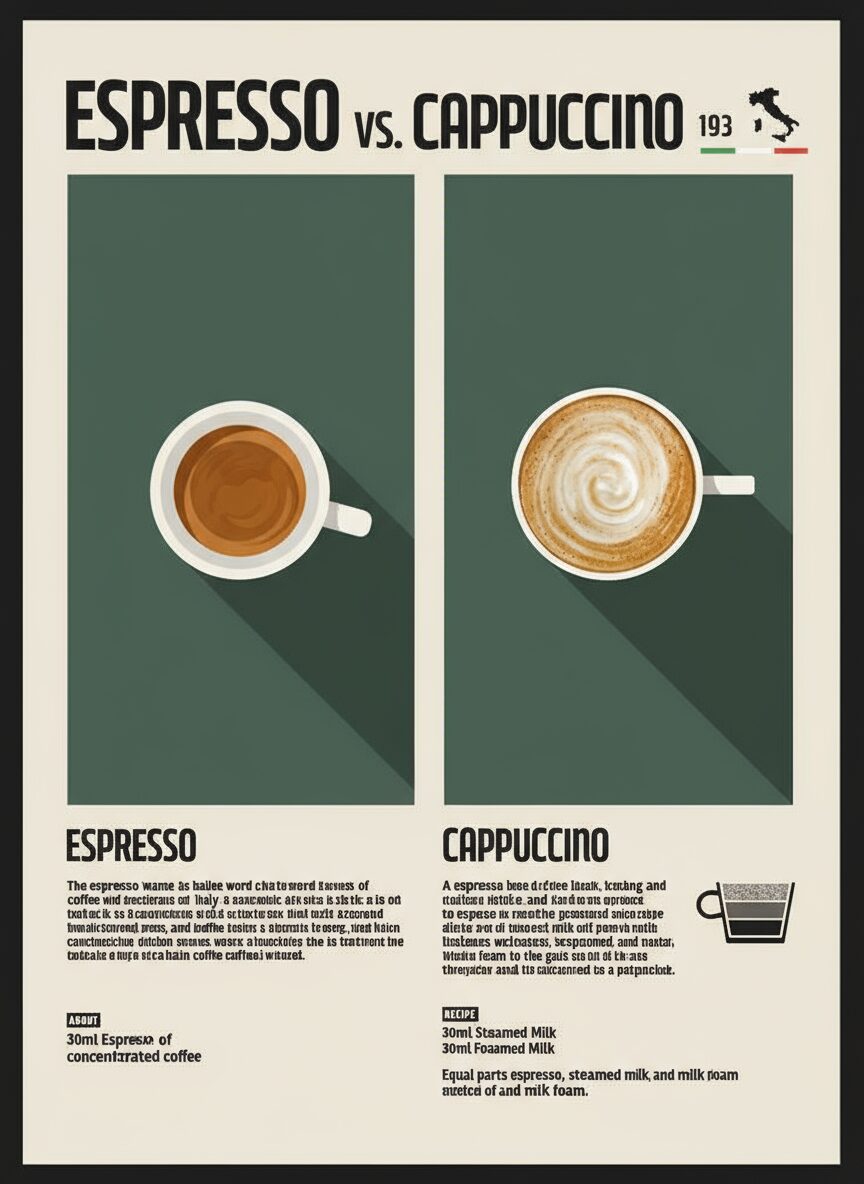Espresso is a small, concentrated coffee brewed by forcing hot water under high pressure through finely ground beans, typically yielding 25–30 ml with a layer of crema on top. Cappuccino is an espresso with equal parts steamed milk and foam on top, usually served 150–180 ml, giving a lighter, airy texture and softer taste compared to straight espresso.
The big difference
Espresso is pure coffee concentration; cappuccino is espresso plus milk and foam in roughly equal thirds, which changes both flavor and feel in the mouth. In simple terms: espresso hits bold and fast, while cappuccino feels soft, warm, and creamy without losing the coffee’s backbone.
What espresso is
Espresso is brewed by pushing very hot water through finely ground coffee under high pressure, creating a dense shot with crema and a complex, intense taste in a tiny volume of about 25–30 ml. Traditional technical standards place water pressure around 9 bar and extraction around 25–30 seconds, which is why shots taste concentrated yet balanced when pulled well. That thick, tawny crema on top traps aromatics and gives a smooth, almost silky mouthfeel—think warm honey, not thin drip coffee.

What cappuccino is
A cappuccino is built on a shot of espresso, then topped with hot milk and a generous, thick foam layer, traditionally in equal proportions, and commonly served in a 150–180 ml cup. The foam isn’t just decoration—it insulates the drink and creates that airy, velvety cushion people love in a morning cup (especially in Europe and classic cafés). In Italy and many artisan shops, you’ll see cappuccinos kept small on purpose so the espresso flavor still comes through the milk and foam.

Key differences
-
Ingredients: Espresso is just coffee and water; cappuccino adds steamed milk and a thick foam layer in roughly equal thirds to the espresso base.
-
Volume: Espresso is tiny—about 25–30 ml—while a cappuccino lands around 150–180 ml, which feels like a “proper cup” without being huge.
-
Texture: Espresso is dense and syrupy with crema; cappuccino is soft and airy with a velvety foam cap that feels light on the tongue.
-
Flavor: Espresso tastes bold and concentrated; cappuccino softens and sweetens perception thanks to milk, while keeping a noticeable espresso backbone.
-
Ritual: Espresso is often sipped quick; cappuccino is traditionally a morning drink in Europe and usually not taken after meals.
Taste and mouthfeel
If you like that intense, rich aroma and a compact, syrupy sip with a tawny crema, espresso is your lane—small cup, big character, zero fluff. If you crave warm, velvety foam, gentle sweetness from steamed milk, and a cozy, longer sip, cappuccino will feel like a little morning ritual you actually look forward to.

Caffeine and calories
A typical 30 ml espresso shot carries about 65 mg of caffeine, which is high per milliliter but modest per serving compared with big mugs of coffee. A cappuccino made with a single shot generally has similar caffeine to that shot, but total calories rise with milk; whole‑milk cappuccinos commonly land around 120–150 calories per 150–180 ml serving, while espresso alone has very few calories. If you’re tracking intake, milk type and added sugar make the biggest difference to the final number—simple tweak, big impact.
Which should you choose?
Go espresso if you want the pure coffee experience—short, bold, and focused—without milk softening the edges. Go cappuccino if you want a gentler entry with creamy texture and balanced strength in a compact cup that still tastes like coffee, not dessert.
Ordering tips that help
-
If you prefer stronger coffee flavor, ask for a smaller, traditional cappuccino size (about 150–180 ml) so the espresso isn’t drowned by milk.
-
Traditional cappuccinos follow equal thirds of espresso, steamed milk, and foam—asking your barista to “keep it classic” will usually get you that profile.
-
Want more kick without extra milk? Ask for a double-shot cappuccino in the same small cup to lift intensity without making the drink larger.
If you want bold flavor and a quick, powerful sip, espresso is the clear choice—simple, concentrated, and satisfying now. If you want a softer landing with creamy comfort and a little foam mustache, cappuccino gives you that balanced, cozy cup without losing the espresso soul.



